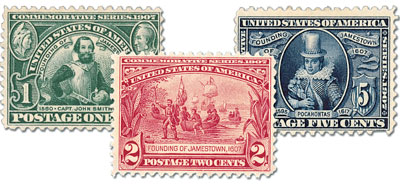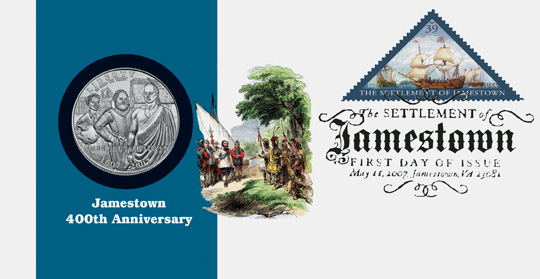
# 4136 FDC - 2007 41c Settlement of Jamestown
2007 41¢ Settlement of Jamestown
City: Jamestown, VA
Quantity: 60,000,000
Method: Lithographed
Settlement Of Jamestown

On May 14, 1607, America’s first permanent English settlement was established at Jamestown, Virginia.
England’s Queen Elizabeth I granted Sir Walter Raleigh permission to establish a colony in America in 1584. Raleigh sent several expeditions to the New World, but they all failed due to inadequate supplies. At that time, Raleigh and the queen gave the name Virginia to the east coast of America, after Elizabeth who was known as the “virgin queen.”

In 1606, King James I chartered the Virginia Company travel to America in search of gold and silver as well as a river route to the Pacific to open trade with Asia. For many of the men, it was a chance “to seek new worlds for gold, for praise, and glory.” About 100 colonists left England in late December 1606 aboard three ships, the Susan Constant, the Godspeed, and the Discovery. After a four-month journey across the Atlantic, they arrived off the coast of America where they saw “faire meddowes and goodly tall trees.” While anchored there, the men formed a governing council before deciding where to make landfall.
They finally selected a site along present-day Virginia’s Chesapeake Bay. The men made landfall on May 14, 1607 and named the small peninsula settlement and nearby river in honor of their king, James I. At Jamestown, the first representative government of the American continent was established. However, the site of the settlement was a poor choice, the men were ill equipped for manual labor, and disease took a heavy toll. Additionally, no gold was found, and the men showed little interest in farming the land.

Although Jamestown’s first settlers were all men, women arrived the following year in 1608. Most historians agree that the colony wouldn’t have survived permanently without women. Brave and daring, they were willing to leave the comfort and safety of their homeland to face the challenges of the untamed wilderness in Virginia. The arrival of women created a sense of stability and permanence, making Virginia home, not just a temporary place to make a profit or find adventure.
The first two women arrived in October 1608 on the ship Mary and Margaret. Mistress Forrest was joining her husband, but sickened on the three-month long journey and reportedly died within a month after arriving. The second woman, 14-year-old Anne Burras, had been Mistress Forrest’s personal maid. She married carpenter John Laydon just three months after her arrival. They were the first couple to be married in Jamestown, and were also the parents of the first English child born in Jamestown in December 1609. Virginia was the first of four daughters born to the couple, the others being Margaret, Katherine, and Alice. John and Anne were among the lucky few who survived the “Starving Time” during the winter of 1609-10.

Temperance Flowerdew landed at Jamestown in the fall of 1609, along with 400 other settlers who had sailed from England in a nine-vessel fleet. Unfortunately, the boat loaded with food supplies was shipwrecked off Bermuda causing the “Starving Time.” Although 80 percent of Jamestown’s 500 inhabitants died of sickness, disease or starvation during that winter, Temperance survived. She returned to England, and in 1619, came back to Jamestown as the wife of Governor George Yeardley. When George died in 1627, Temperance stayed and married the new Governor, Francis West. She remained in Virginia for the rest of her life.
That the colony survived at all in those first years was due to the strong leadership of Captain John Smith. Born in England, John Smith was a soldier and adventurer who fought for many causes. He fought with the Dutch against the Spanish, and in Eastern Europe against the Turks. Smith was even captured and enslaved by the Turks until he escaped to Russia.

At Jamestown, Smith established a law that those who would not work, would not eat! But it was hard to convince the fortune-seeking colonists to stop looking for gold and silver in order to work at less lucrative endeavors. Smith criticized the Virginia Company for its impractical choice of settlers and begged them to send colonists who could build and farm. At one point, Smith was taken captive by the Powhatan Indians, and “saved” by ten-year-old Pocahontas. Legend has it that as Captain Smith knelt with his head upon a sacrificial stone, awaiting death by Indian war clubs, Pocahontas leaped between him and her father. Cradling his head in her arms, she begged her father not to kill him. Smith credited Pocahontas with much of the success of the colony, stating that she had saved it from “death, famine and utter confusion.”
Unfortunately, Captain Smith was severely wounded in a gunpowder accident in 1609 and had to return to England. Without Smith’s leadership, the colony floundered. During the following winter, many colonists died of starvation. In the spring, the colonists began to leave Jamestown, but were met by supply ships led by Governor Thomas West, who was also known as Lord De La Warr.

In 1612, colonist John Rolfe brought the settlement economic success when he introduced a new strain of tobacco from Trinidad. The new tobacco did well in the Virginia climate and was much sweeter when smoked. Rolfe also developed a new method for curing the tobacco leaves, and proved that tobacco could be exported to Europe. This product allowed the colony to survive economically. Rolfe married Pocahontas, the daughter of the chief of the Indian confederation around Jamestown, in 1614. This marriage brought peace between the Indians and the colonists.
2007 41¢ Settlement of Jamestown
City: Jamestown, VA
Quantity: 60,000,000
Method: Lithographed
Settlement Of Jamestown

On May 14, 1607, America’s first permanent English settlement was established at Jamestown, Virginia.
England’s Queen Elizabeth I granted Sir Walter Raleigh permission to establish a colony in America in 1584. Raleigh sent several expeditions to the New World, but they all failed due to inadequate supplies. At that time, Raleigh and the queen gave the name Virginia to the east coast of America, after Elizabeth who was known as the “virgin queen.”

In 1606, King James I chartered the Virginia Company travel to America in search of gold and silver as well as a river route to the Pacific to open trade with Asia. For many of the men, it was a chance “to seek new worlds for gold, for praise, and glory.” About 100 colonists left England in late December 1606 aboard three ships, the Susan Constant, the Godspeed, and the Discovery. After a four-month journey across the Atlantic, they arrived off the coast of America where they saw “faire meddowes and goodly tall trees.” While anchored there, the men formed a governing council before deciding where to make landfall.
They finally selected a site along present-day Virginia’s Chesapeake Bay. The men made landfall on May 14, 1607 and named the small peninsula settlement and nearby river in honor of their king, James I. At Jamestown, the first representative government of the American continent was established. However, the site of the settlement was a poor choice, the men were ill equipped for manual labor, and disease took a heavy toll. Additionally, no gold was found, and the men showed little interest in farming the land.

Although Jamestown’s first settlers were all men, women arrived the following year in 1608. Most historians agree that the colony wouldn’t have survived permanently without women. Brave and daring, they were willing to leave the comfort and safety of their homeland to face the challenges of the untamed wilderness in Virginia. The arrival of women created a sense of stability and permanence, making Virginia home, not just a temporary place to make a profit or find adventure.
The first two women arrived in October 1608 on the ship Mary and Margaret. Mistress Forrest was joining her husband, but sickened on the three-month long journey and reportedly died within a month after arriving. The second woman, 14-year-old Anne Burras, had been Mistress Forrest’s personal maid. She married carpenter John Laydon just three months after her arrival. They were the first couple to be married in Jamestown, and were also the parents of the first English child born in Jamestown in December 1609. Virginia was the first of four daughters born to the couple, the others being Margaret, Katherine, and Alice. John and Anne were among the lucky few who survived the “Starving Time” during the winter of 1609-10.

Temperance Flowerdew landed at Jamestown in the fall of 1609, along with 400 other settlers who had sailed from England in a nine-vessel fleet. Unfortunately, the boat loaded with food supplies was shipwrecked off Bermuda causing the “Starving Time.” Although 80 percent of Jamestown’s 500 inhabitants died of sickness, disease or starvation during that winter, Temperance survived. She returned to England, and in 1619, came back to Jamestown as the wife of Governor George Yeardley. When George died in 1627, Temperance stayed and married the new Governor, Francis West. She remained in Virginia for the rest of her life.
That the colony survived at all in those first years was due to the strong leadership of Captain John Smith. Born in England, John Smith was a soldier and adventurer who fought for many causes. He fought with the Dutch against the Spanish, and in Eastern Europe against the Turks. Smith was even captured and enslaved by the Turks until he escaped to Russia.

At Jamestown, Smith established a law that those who would not work, would not eat! But it was hard to convince the fortune-seeking colonists to stop looking for gold and silver in order to work at less lucrative endeavors. Smith criticized the Virginia Company for its impractical choice of settlers and begged them to send colonists who could build and farm. At one point, Smith was taken captive by the Powhatan Indians, and “saved” by ten-year-old Pocahontas. Legend has it that as Captain Smith knelt with his head upon a sacrificial stone, awaiting death by Indian war clubs, Pocahontas leaped between him and her father. Cradling his head in her arms, she begged her father not to kill him. Smith credited Pocahontas with much of the success of the colony, stating that she had saved it from “death, famine and utter confusion.”
Unfortunately, Captain Smith was severely wounded in a gunpowder accident in 1609 and had to return to England. Without Smith’s leadership, the colony floundered. During the following winter, many colonists died of starvation. In the spring, the colonists began to leave Jamestown, but were met by supply ships led by Governor Thomas West, who was also known as Lord De La Warr.

In 1612, colonist John Rolfe brought the settlement economic success when he introduced a new strain of tobacco from Trinidad. The new tobacco did well in the Virginia climate and was much sweeter when smoked. Rolfe also developed a new method for curing the tobacco leaves, and proved that tobacco could be exported to Europe. This product allowed the colony to survive economically. Rolfe married Pocahontas, the daughter of the chief of the Indian confederation around Jamestown, in 1614. This marriage brought peace between the Indians and the colonists.






